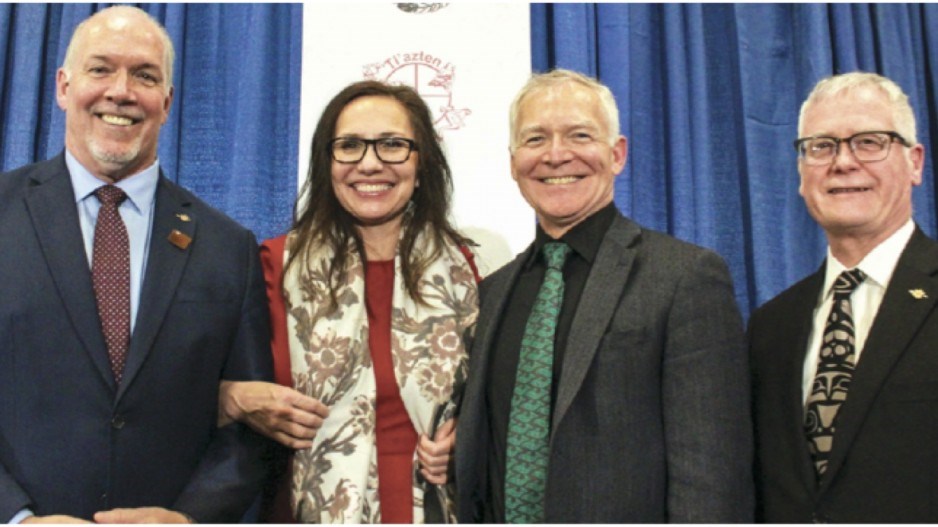Even as Indigenous activists supporting a handful of Wet’suwet’en hereditary chiefs opposed to the Coastal GasLink pipeline were chanting “Reconciliation is dead,” government and industry in B.C. were busy signing deals with First Nations that suggest it isn’t.
It may be dead for those who define reconciliation as a fight for a zero-sum outcome. But those First Nations who view it as an ongoing process of negotiation, and who have done the hard work of sorting out governance issues, have found a provincial government very much willing to address issues of rights, title and economic reconciliation.
With the troubles in Wet’suwet’en country hogging all the headlines, it was easy to miss a $200 million reconciliation agreement signed between the B.C. government and the Carrier Sekani Tribal Council at the end of January.
More recently, the Huu-ay-aht First Nations has inked a deal that makes it business partners with Western Forest Products (TSX:WFP), with a majority stake in a tree farm licence (TFL 44) and a 7% stake in the company’s Port Alberni sawmill.
Interestingly, one of the seven bands that are part of the deal with the Carrier Sekani Tribal Council is Burns Lake – also known as the Wet’suwet’en First Nation, a mix of both Wet’suwet’en and Carrier First Nations.
The Pathway Forward agreement with the Carrier Sekani includes seven bands with a total population of about 7,000.
It is not a treaty, per se, though it could be described as the cornerstone of one. It commits to an ongoing process to recognize and implement rights of title and self-government.
It is very much an economic reconciliation agreement, however – an acknowledgment that things like title and self-governance don’t mean much if First Nations don’t have the economic means to govern themselves and manage their lands and economies.
“When you have money in the bank, you are able to do more things the way you want to,” said Carrier Sekani Tribal Council Chief Mina Holmes. “So our community can comfortably deliver language programs. Before, we had to apply for language funds. They were often limited. Now leadership can do language and culture in the community with its members.”
The $200 million in funding flows through four categories: economic development, culture, governance, and capacity building. It provides $70 million for economic development, including $15 million to seed a new sovereign wealth fund.
“This idea came from what we saw [with] the Navajo Nation,” Holmes said. “They started with $10 million and they have $200 million now.”
There is also a provision to provide revenue from activity like forestry to the Carrier Sekani.
“There are issues there that are so long overdue to be addressed, and we feel that this government has attempted to start addressing that with tackling those big issues and working with First Nations to address what the future of forestry might be,” Holmes said.
The Carrier Sekani is still officially listed as involved in the B.C. treaty process, but it abandoned that process years ago, Holmes said, opting to work directly with the provincial government.
The Pathway Forward agreement signed at the end of January started under the Liberal government, but Holmes credited the NDP government for getting the deal signed, sealed and delivered.
“We have been making steady progress, particularly with this government,” Holmes said. “Progress has definitely been made.”
Coinciding with the economic reconciliation agreement is the Omineca Demonstration Project, which deals with land stewardship and habitat issues.
Over on Vancouver Island, meanwhile, the B.C. government has also helped facilitate an agreement between the Huu-ay-aht First Nations and Western Forest Products that will see the Huu-ay-aht become WFP’s business partner.
The Huu-ay-aht have taken a 51% controlling interest in TFL 44 (Port Alberni) for $35 million. WFP has the long-term lease on that TFL, which is Crown land held under a renewable 25-year lease. They will also take a $1 million, 7% stake in WFP’s Port Alberni sawmill.
The money is coming from the Huu-ay-aht’s own funds – a combination of cash provided through the Maa-nulth treaty agreement (signed in 2011), bank loans and revenue from the Huu-ay-aht’s forestry business.
Huu-ay-aht Chief Councillor Robert Dennis said the deal would never have been possible without a treaty – which gave the Huu-ay-aht ownership of 9,000 hectares of timberlands – and without a governance structure that involves both hereditary and elected leaders working co-operatively.
“Progress is being made where the First Nation communities – hereditary leaders and elected leaders – are working together,” Dennis said.
“Our financial position is now 45 times greater than when we entered treaty,” he added. “We have a very healthy investment bank account from our forestry operations and our government operations.”
Western Forest Products CEO Don Demens said the deal benefits his company because it provides greater certainty over timber supply, some of which comes from Huu-ay-aht timberlands that are outside of TFL 44.
“I think this is a template where First Nations can invest, with business, to support a stronger business, and it’s a way business can contribute to reconciliation,” Demens said. “It creates greater certainty of access to fibre for our business, which supports business in B.C.”




